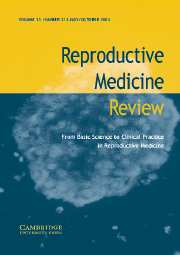Article contents
Paternal conributions to embryogenesis
Published online by Cambridge University Press: 13 February 2001
Abstract
The ejaculate is analyzed in the clinic primarily to obtain an estimation of sperm number, motion characteristics and cell morphology. Based on these data, conclusions are formulated as to the overall ‘fertility’ of the male. A major problem has been that the conclusions derived are often not (well) correlated with expected outcome, i.e., fertility. As a consequence, adjunct tests, e.g., sperm function tests, have been developed in an effort to uncover those defects/assets not revealed when measuring standard semen parameters. While some of these tests, e.g., hemizona assay, have helped to shed light on dysfunctional processes associated with fertilization, e.g., zona binding and penetration, individually they do not totally suffice for identifying fertile (defined as being capable of producing offspring) males.
- Type
- Research Article
- Information
- Copyright
- © 2000 Cambridge University Press
- 12
- Cited by


